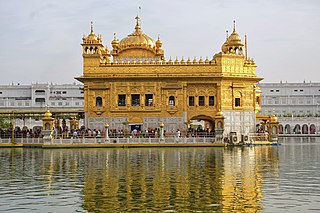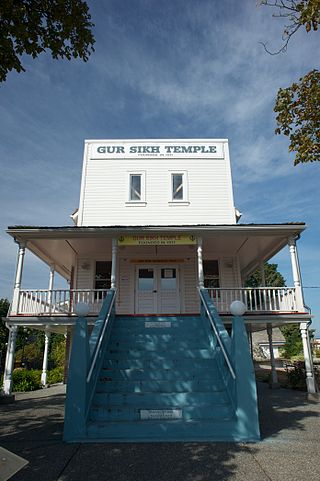A gurdwara is a place of assembly and worship for Sikhs. Sikhs also refer to gurdwaras as Gurdwara Sahib. People from all faiths are welcomed in gurdwaras. Each gurdwara has a Darbar Sahib where the Guru Granth Sahib is placed on a takhat in a prominent central position. Any congregant may recite, sing, and explain the verses from the Guru Granth Sahib, in the presence of the rest of the congregation.

Vaisakhi, also pronounced Baisakhi as well as Basoa, marks the first day of the month of Vaisakh and is traditionally celebrated annually on 13 April and sometimes 14 April. It is seen as a celebration of spring harvest primarily in Northern India. Further, other Indian cultures and diaspora celebrate this festival too. Whilst it is culturally significant as a festival of harvest, in many parts of India, Vaisakhi is also the date for the Indian Solar New Year. According to legend, some 5298 years ago, on this day Raja Shaktikaran Dogra, also known as Raja Shastri, commenced the Shastra Samvat alias Dogra-Pahari Calendar, so this day predates special historical significance with Dogras of Himalayas.

The Shiromani Gurdwara Parbandhak Committee is an organization in India responsible for the management of Gurdwaras, Sikh places of worship in states of Punjab and Himachal Pradesh and the union territory of Chandigarh. SGPC also administers Darbar Sahib in Amritsar.

Gurudwara Bangla Sahib is one of the most prominent Sikh gurdwaras, or Sikh house of worship, in Delhi, India, and known for its association with the eighth Sikh Guru, Guru Har Krishan, as well as the holy pond inside its complex, known as the "Sarovar." It was first built as a small shrine by Sikh General Sardar Baghel Singh in 1783, on the bungalow donated by king Raja Jai Singh of Amer, who supervised the construction of nine Sikh shrines in Delhi in the same year, during the reign of Mughal Emperor, Shah Alam II.

Little India is an ethnic district in Singapore. It is located east of the Singapore River – across from Chinatown, located west of the river – and north of Kampong Glam. Both areas are part of the urban planning area of Rochor. Little India is commonly known as Tekka in the Indian Singaporean community.

Anandpur Sahib, also referred simply as Anandpur, is a city in Rupnagar district (Ropar), on the edge of Shivalik Hills, in the Indian state of Punjab. Located near the Sutlej River, the city is one of the most sacred places in Sikhism, being the place where the last two Sikh Gurus, Guru Tegh Bahadur and Guru Gobind Singh, lived. It is also the place where Guru Gobind Singh founded the Khalsa Panth in 1699. The city is home to Takhat Sri Kesgarh Sahib, Third of the five Takhts in Sikhism.

Fatehgarh Sahib is a city and a sacred pilgrimage site of Sikhism in the north west Indian state of Punjab. It is the headquarters of Fatehgarh Sahib district, located about 5 kilometres (3.1 mi) north of Sirhind. Fatehgarh Sahib is named after Fateh Singh, the 7-year-old son of Guru Gobind Singh, who was seized and buried alive, along with his 9-year-old brother Zoravar Singh, by the Mughals under the orders of governor Wazir Khan during the ongoing Mughal-Sikh wars of the early 18th century. The town experienced major historical events after the martyrdom of the sons in 1705, with frequent changes of control between the Sikhs and Mughals.

Bencoolen Street is a street in Central, Singapore that starts at the junction of Rochor Road, Rochor Canal Road and Jalan Besar and ends at the junction of Fort Canning Road, Stamford Road and Orchard Road. The street houses several landmarks including Sim Lim Square, Bencoolen Mosque and Albert Complex. A number of hotels and serviced apartments exist, namely Summer View Hotel, Bayview Hotel Singapore, Hotel 81 Bencoolen, Strand Hotel, Rendezvous Hotel and Somerset Bencoolen. It is accessible via Bencoolen MRT station which is located under Bencoolen Street itself.

Mosque Street is a one-way street located in Chinatown within the Outram Planning Area in Singapore. The road links South Bridge Road to New Bridge Road near Chinatown MRT station.

Trengganu Street is a street located in Chinatown within the Outram Planning Area in Singapore.

Kreta Ayer Road is a one-way road located in Chinatown within the Outram Planning Area in Singapore. The road links Neil Road to New Bridge Road and Eu Tong Sen Street, and is intersected by Keong Saik Road.

Keong Saik Road is a one-way road located in Chinatown within the Outram Planning Area in Singapore. The road links New Bridge Road to Neil Road, and is intersected by Kreta Ayer Road.

Tras Street is a street located in Tanjong Pagar in the Outram Planning Area and Downtown Core in Singapore. The road connects Enggor Street and Gopeng Street to Cook Street, and is intersected by Wallich Street.

The Khalsa Diwan Society Vancouver is a Sikh gurdwara organization in Vancouver, British Columbia, Canada.

Choor Singh Sidhu, known professionally as Choor Singh, was a Singaporean lawyer who served as a judge of the Supreme Court of Singapore and, particularly after his retirement from the bench, a philanthropist and writer of books about Sikhism. Born to a family of modest means in Punjab, India, he came to Singapore at four years of age. He completed his secondary education in the top class at Raffles Institution in 1929, then worked as a clerk in a law firm before becoming a civil servant in the Official Assignee's office.

The Golden Temple is a gurdwara located in the city of Amritsar, Punjab, India. It is the preeminent spiritual site of Sikhism. It is one of the holiest sites in Sikhism, alongside the Gurdwara Darbar Sahib Kartarpur in Kartarpur, and Gurdwara Janam Asthan in Nankana Sahib.

Sikhism in the United Arab Emirates has a following of over 50,000; the majority of Sikhs in the UAE can be found in Dubai, Abu Dhabi or Sharjah.

The Gur Sikh Temple, in Abbotsford, British Columbia, is the oldest existing Sikh gurdwara in North America and a National Historic Site Canada. It is the only gurdwara outside of India and Pakistan that is designated as national historic site.

Sikhism in Greater Vancouver is one of the main religions across the region, especially among the Indo-Canadian population. The Sikh community in Vancouver is the oldest, largest and most influential across Canada, having begun in the late 19th century.

Sikhism in Bangladesh has an extensive heritage and history, although Sikhs had always been a minority community in Bengal. Their founder, Guru Nanak visited a number of places in Bengal in the early sixteenth century where he introduced Sikhism to locals and founded numerous establishments. In its early history, the Sikh gurus despatched their followers to propagate Sikh teachings in Bengal and issued hukamnamas to that region. Guru Tegh Bahadur lived in Bengal for two years, and his successor Guru Gobind Singh also visited the region. Sikhism in Bengal continued to exist during the colonial period as Sikhs found employment in the region, but it declined after the partition in 1947. Among the eighteen historical gurdwaras in Bangladesh, only five are extant. The Gurdwara Nanak Shahi of Dhaka is the principal and largest gurdwara in the country. The Sikh population in the country almost entirely consists of businessmen and government officials from the neighbouring Republic of India.



















